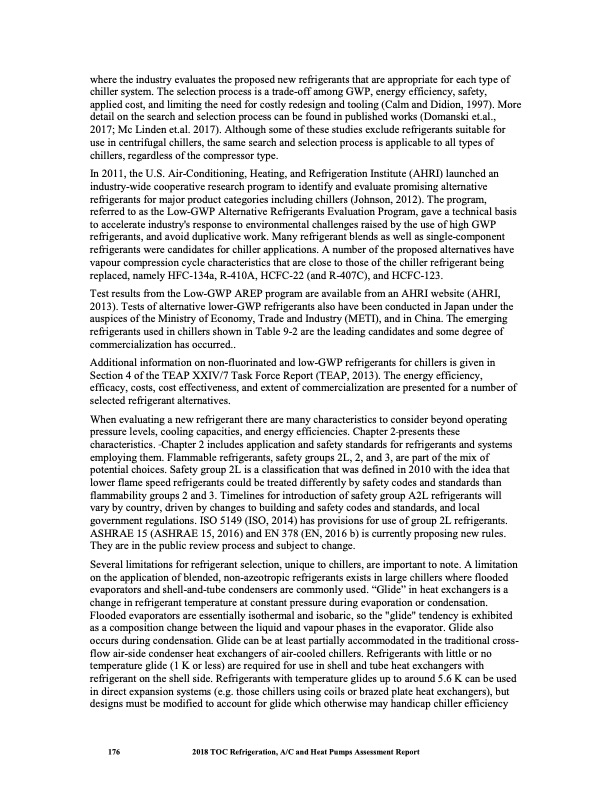
PDF Publication Title:
Text from PDF Page: 189
where the industry evaluates the proposed new refrigerants that are appropriate for each type of chiller system. The selection process is a trade-off among GWP, energy efficiency, safety, applied cost, and limiting the need for costly redesign and tooling (Calm and Didion, 1997). More detail on the search and selection process can be found in published works (Domanski et.al., 2017; Mc Linden et.al. 2017). Although some of these studies exclude refrigerants suitable for use in centrifugal chillers, the same search and selection process is applicable to all types of chillers, regardless of the compressor type. In 2011, the U.S. Air-Conditioning, Heating, and Refrigeration Institute (AHRI) launched an industry-wide cooperative research program to identify and evaluate promising alternative refrigerants for major product categories including chillers (Johnson, 2012). The program, referred to as the Low-GWP Alternative Refrigerants Evaluation Program, gave a technical basis to accelerate industry's response to environmental challenges raised by the use of high GWP refrigerants, and avoid duplicative work. Many refrigerant blends as well as single-component refrigerants were candidates for chiller applications. A number of the proposed alternatives have vapour compression cycle characteristics that are close to those of the chiller refrigerant being replaced, namely HFC-134a, R-410A, HCFC-22 (and R-407C), and HCFC-123. Test results from the Low-GWP AREP program are available from an AHRI website (AHRI, 2013). Tests of alternative lower-GWP refrigerants also have been conducted in Japan under the auspices of the Ministry of Economy, Trade and Industry (METI), and in China. The emerging refrigerants used in chillers shown in Table 9-2 are the leading candidates and some degree of commercialization has occurred.. Additional information on non-fluorinated and low-GWP refrigerants for chillers is given in Section 4 of the TEAP XXIV/7 Task Force Report (TEAP, 2013). The energy efficiency, efficacy, costs, cost effectiveness, and extent of commercialization are presented for a number of selected refrigerant alternatives. When evaluating a new refrigerant there are many characteristics to consider beyond operating pressure levels, cooling capacities, and energy efficiencies. Chapter 2 presents these characteristics. Chapter 2 includes application and safety standards for refrigerants and systems employing them. Flammable refrigerants, safety groups 2L, 2, and 3, are part of the mix of potential choices. Safety group 2L is a classification that was defined in 2010 with the idea that lower flame speed refrigerants could be treated differently by safety codes and standards than flammability groups 2 and 3. Timelines for introduction of safety group A2L refrigerants will vary by country, driven by changes to building and safety codes and standards, and local government regulations. ISO 5149 (ISO, 2014) has provisions for use of group 2L refrigerants. ASHRAE 15 (ASHRAE 15, 2016) and EN 378 (EN, 2016 b) is currently proposing new rules. They are in the public review process and subject to change. Several limitations for refrigerant selection, unique to chillers, are important to note. A limitation on the application of blended, non-azeotropic refrigerants exists in large chillers where flooded evaporators and shell-and-tube condensers are commonly used. “Glide” in heat exchangers is a change in refrigerant temperature at constant pressure during evaporation or condensation. Flooded evaporators are essentially isothermal and isobaric, so the "glide" tendency is exhibited as a composition change between the liquid and vapour phases in the evaporator. Glide also occurs during condensation. Glide can be at least partially accommodated in the traditional cross- flow air-side condenser heat exchangers of air-cooled chillers. Refrigerants with little or no temperature glide (1 K or less) are required for use in shell and tube heat exchangers with refrigerant on the shell side. Refrigerants with temperature glides up to around 5.6 K can be used in direct expansion systems (e.g. those chillers using coils or brazed plate heat exchangers), but designs must be modified to account for glide which otherwise may handicap chiller efficiency 176 2018 TOC Refrigeration, A/C and Heat Pumps Assessment ReportPDF Image | Heat Pumps Technical Options

PDF Search Title:
Heat Pumps Technical OptionsOriginal File Name Searched:
RTOC-assessment-report-2018_0.pdfDIY PDF Search: Google It | Yahoo | Bing
CO2 Organic Rankine Cycle Experimenter Platform The supercritical CO2 phase change system is both a heat pump and organic rankine cycle which can be used for those purposes and as a supercritical extractor for advanced subcritical and supercritical extraction technology. Uses include producing nanoparticles, precious metal CO2 extraction, lithium battery recycling, and other applications... More Info
Heat Pumps CO2 ORC Heat Pump System Platform More Info
| CONTACT TEL: 608-238-6001 Email: greg@infinityturbine.com | RSS | AMP |